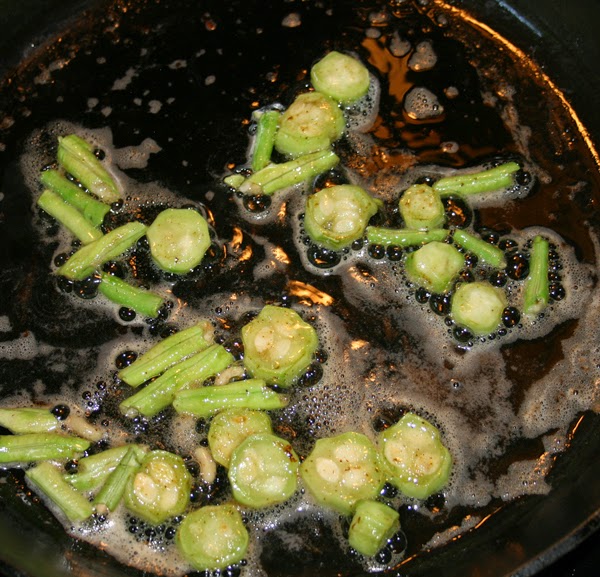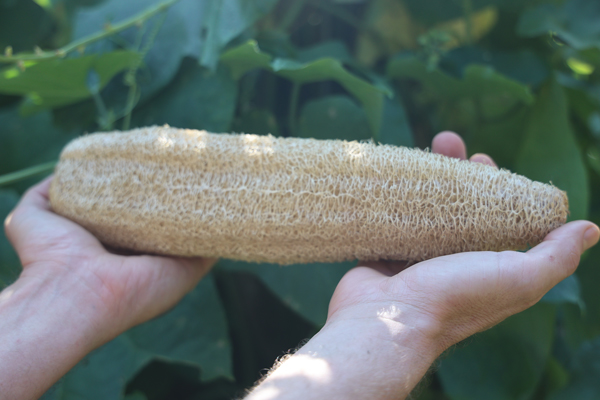Growing luffas is quite an adventure. It’s not for the faint of heart, or for the gardener who needs everything to stay in its lane. With that in mind, it’s easy to grow luffas and you can have all the sponges you ever wanted in just a single gardening season.
Gary’s Luffas and Our Accidental Angle Gourds
You can grow luffas almost anywhere. Even in lousy South Florida sand.
Gary’s Runaway Luffas
A couple of decades ago my late friend Gary stayed with my grandparents for a period of time. Gary was a free spirit – especially when it came to gardening, so he planted luffas along their back fence.
Probably without asking.
This being South Florida, they had a long season to run and run and run. (If you haven’t grown luffas before, you might be shocked by the way their growth compares to kudzu!)
I recall vines on the fence, up the edges of trees, rambling along the ground and invading the no-man’s-land strip into the neighbor’s yard. Overall, the rank profusion of growth was too much for my grandparents. I’m pretty sure they had him take down the vines after they’d covered a few hundred feet of their yard. Afterwards, I remember Gary drying piles of green, yellow and brown luffa fruits on improvised racks.
There were enough luffa sponges grown in that backyard to give the Tarpon Springs sponge divers a run for their money.

Photo credit: VisitStPeteClearwater.com/Jacob Pierce
The Accidental Angle Gourds
Years later I got some luffa seeds of my own from somewhere and I planted some in the North Florida Food Forest. They fruited, however, they weren’t smooth and rounded.
Instead, they looked like green Hindenburg Zeppelins with acute ridges.

Growing luffa gets you sponges. Growing angle gourd gets you Zeppelins!
And they were almost impossible to peel.
I had inadvertently planted the Angle Gourd, AKA Luffa acutangula.
The young fruits were quite good to eat when cooked, but the mature fruits weren’t any good for sponges, which is why we had planted them in the first place! Stripping the skins from the skeleton was almost impossible, unlike the standard sponge variety.
At least we got some good stir-fries.

Luffa in the Wild
At the beautiful beach of La Sagesse in Grenada, there was a large Tropical Almond tree by the resort. Every rainy season that tree was covered with luffa vines. We also found a wild patch of them down by the river on a farm we rented in St. David’s.
One day we made the mistake of cooking and eating these wild luffa. You can read about that unfortunate escapade here.
We had toxic squash syndrome before it was cool.
That soured us on luffa for a while. At least as a vegetable.
A while that continues to this day. Nothing says “delicious stir-fry” like chills, vomiting and profound intestinal distress.
Luffa seems to do pretty well in the wild. We saw some growing behind a Chinese restaurant lately, climbing an oak tree. They had been deliberately planted, but were growing in rough conditions. We’ve also had them self-seed off a porch where we were cleaning sponges. Our friend Elizabeth had them self-seed as well. I doubt they would continue doing so for multiple years in a temperate climate, but it’s possible. They definitely can maintain a wild population in the tropics, as we witnessed in the Caribbean.
Luffa in Our Gardens
Though our culinary romance with the Luffa genus ended in tears, it’s use as a natural sponge still makes it worth cultivating in our garden. Last year, after buying some homemade soap at a farmer’s market with slices of luffa embedded in each bar, I was reminded what a nice scrubbing implement a luffa skeleton can be.
This spring I planted Luffa aegyptiaca – the sponge type, not the Zeppelin type – on one of the solid cattle panel trellises we built.
It shares the trellis with Jamaican yellow yams and velvet beans.
It struggled with their vigorous vines in a three way death match for some time before striking out in multiple tentacles across the herb garden, over the Blessed Mother, across the chaste tree, through the invading carpet of sensitive plant, and onto the concrete patio, where it has been placing long luffa fruit like lounging grey-green manatees on a bed of Mimosa pudica.

Its growth has been so vigorous that I have been tempted to slash it all back to the trellis with my machete; however, it barely made any fruits on the trellis. It instead produced them elsewhere, on its most invasive vines, flowering profusely and setting fruit at its extremities.
All there is to do now is wait for the cold to knock them back.
This year’s luffa vines should supply us with sponges for the next couple of years, with enough for the sink, the shower and some extra to give away.
When my mother-in-law visited recently she was admiring a luffa sponge we had just harvested and cleaned. She had always thought they had come from the ocean. They sure got close when we saw them along the beach at La Sagesse. But no, that sponge didn’t come from the actual ocean. Instead it came from the thick ocean of vines washing over our garden like a deep green storm surge.
Next year I might just have to plant them further out. Perhaps growing luffas along fences and trees, like Gary did. There is something awe-inspiring about a plant that can grow and bear so abundantly in a single season. If we get as many sponges as I think we will, I might wait two years before I plant them again. Or three. Though I’ll probably just plant them again in the food forest, since they’re really fun to watch grow.
When the fall frosts come and the harvests are done, I’ll be sure to share how many sponges we got. Until then, here’s a quick video on how we process luffa.
Growing Luffas in Your Own Garden
Growing luffas is a ton of fun – I highly recommend it. Just be ready for them to invade and conquer everything their tendrils can grasp.
Here’s how to grow them.
Getting Luffa Seeds
We have seen Luffa seeds for sale at multiple rare seed shops. Baker Creek usually has them, as does my daughter Daisy in her Etsy store.
Planting
Plant seeds in spring after all danger of frost. Make sure you are growing luffas near a strong trellis and give them lots of room. Having them fight with yams and velvet beans is not recommended. One vine can run for twenty feet or more, so give them lots of space. Moderately fertile soil is good, but they aren’t picky.
Fruiting and Harvest
Luffas make male blooms first, followed by female blooms. Just wait – it takes luffas a long time to really get producing. Ours were in the ground for a few months before making their first three or four fruit. They then paused in fruiting, invaded the herb garden, and went on to make a whole second round of fruit along these wandering vines, producing many, many more.
When luffas are brown, they are ready to harvest. Let them dry until the skins are crispy – either on the vine or off it – and then crush off the skins. The inside is filled with seeds, but one end of the fruit is easy to break off to release them. Shake out the seeds and save them for next year. You’ll get enough seeds in one fruit to grow an acre of luffas!
You can then cut your sponge into convenient “rounds,” or just use it entire. The dried luffa skeletons keep forever.
Eating Luffas
Young fruit can be eaten cooked when they are about the size of a cucumber, but if you wait too long they’ll get very fibrous and are inedible. If fruits taste bitter, do not eat them. That is a sign of cucurbitacin, a dangerous toxin. Young (non-bitter!) fruits are delicious when stir-fried. Luffa soaks up the flavor of whatever you cook it in, and is very popular in Southeast Asian cooking.
SPUDOMETER RATING:

3 out of 5 Spuds
Name: Luffa/Loofah
Latin Name: Luffa aegyptiaca
Type: Vigorous annual vine
Nitrogen Fixer: No
Medicinal: Unknown
Cold-hardy: No
Exposure: Full sun
Part Used: Fruit (young, as vegetable); Mature (as sponges)
Propagation: Seeds
Taste: Like summer squash (must be cooked)
Storability: Indefinite as sponges. Probably a week as a green vegetable
Ease of growing: Easy
Nutrition: Good source of vitamin A and Folate
Recognizability: Moderate
Availability: Moderate

